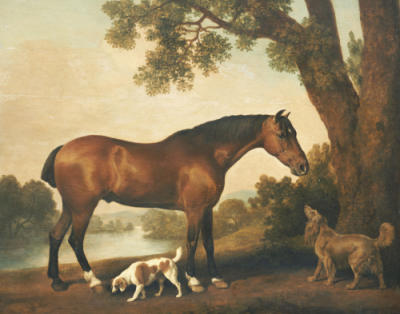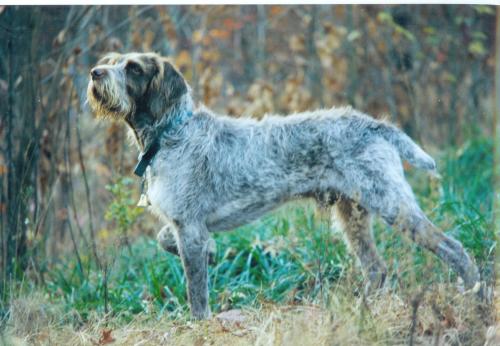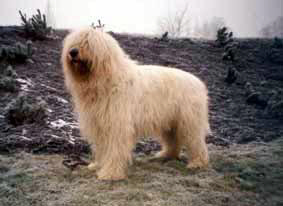
The Dogue de Bordeaux is the last remaining native French mastiff. There were once Parisian dogues, dogues from Toulouse, and the Dogue de Bordeaux. These dogs were often brindle, red with black masks, or marked with white. The dogs may have had lots of purposes, as all mastiff-types did. Their ancestors probably hunted boars, wolves, and other large animals. Some were probably used in war (the famous story of the mastiff defending Sir Peers Legh at the battle of Agincourt was an English mastiff, though, not a French one). Later, they guarded estates. These dogs were powerful and fierce. Unlike the bullmastiff and the big English mastiff, the Dogue de Bordeaux retains some of these traits, some more so than others.
Today, this breed is horribly inbred with a very short life expectancy of about six years. It was made popular for a few years with the film Turner and Hooch, which was an early Tom Hanks film. The dog was a slobbering beast with a charming personality that on occasion went berserk on a bad guy. No wonder Americans wanted one!
***
Another wild French canid was the Beast of Gevaudan that killed scores of peasants in rural France. No one has been able to figure out what it was. A wolf? A hyena? A lion? Maybe a cryptid unknown to science? The story of the Beast was the basis for the film Brotherhood of the Wolf, a 2001 French film. In this film, though, the beast is an armored lioness released upon the peasants to make them hate their king who allowed for scientific thought to exist in France.
But what was the animal? There were two of them, but both were larger than the wolf of the region. Wolf attacks may have happened in Europe, most of them were probably the result of rabies. However, there were child snatching wolves in India that, killed or seriously maimed 74 children from 1996-1997. These people were in the same position as the French peasants. They were poor and unarmed. The forest was nearly empty of game, forcing wolves to rely on livestock for food. It is just a short leap from killing livestock to killing people, and these Indian wolves did it. Could the Gevaudan wolves also made that leap?
There are some problems with this theory. One is that there were only two wolves, and over three years they attacked over 200 people and killed 113 people. In the case of the Indian wolves, whole packs of wolves involved. Further, the French were wolf hunters, unlike the people of this part of India. Although the peasants did not often have guns, the nobles had estate managers and hired hunters to keep the wolf population low. The wolves had a lot more to fear of people in France in 1764 than the wolves had to fear of people in India in 1996. Both of these problems– the volume of the deaths from just two animals and the ability for the French to kill wolves– certainly causes me to doubt that the Beast of Gevaudan was a wolf.
The animals tore at the face and throats of their victims, which is consistent with a dog or wolf attack. Some have suggested that the beast wasn’t a canid at all, but a hyena or a big cat. Big cats were often kept in menageries, but there is no record of any missing big cats in that part of France. Further, no one owned any. The hyena theory does get some people excited, because there is mention of the Beast having stripes and a wolf-like head. However, striped hyenas are only scavengers. They do not hunt. Spotted hyenas are the only hyenas that hunt large prey, and if the Beast had been mottled, the hyena theory might have some merit. (The brown hyena has been known to kill fur seal pups on the coast of Namibia, but those are slow moving prey. The brown hyena is the largest animal that can survive on scavenging alone. Anyway, that species was virtually unknown to Europeans).
In 1765, the King of France had one of his wolf hunters go into the countryside, as well as some of his harquebus bearer and Lieutenant of the Hunt. The French government spent lots of money and manpower trying to kill the beast, but all the came up with was an unusually large wolf, weighing 130 pounds and standing 31 inches at the shoulder. The common wolf of Europe weighs only 75 to 100 pounds. Pure wolves of this size only exist in the wild in far northern parts of North America, which is why I am sure this animal wasn’t a pure wolf. It had scar that the animal had received from its victims as they tried to defend themselves. This “wolf” is sometimes called the Wolf of Chazes, and there are very few good depictions of it other than fanciful nonsense, such as this:

But there is this depiction of it that seems more realistic:

The size is very large for a wolf (and probably not realistic). But the head and really large ears seem to me that this beast was actually a wolf-dog. Large ears are indicative of a wolf-dog cross. Because most modern wolf-dogs are hybrids with wolves and wolf-like dogs, we assume that the wolf hybrids are going to look like wolves. But here are some wolf hybrids from a wolf and standard poodle:
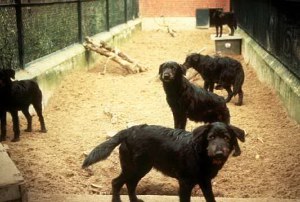
From the goldendoodle website. Could you tell that they were poodle-wolf crosses? They look like some kind of weird dog to me. I don’t think I could determine their species.
The second creature was killed two years later, as people continued to be attacked and killed. One local hunter, Jean Chastel, was charged with the task of kill the beast. And he succeeded, after he had stopped to pray (of course!) and the reign of the Beast of Gevaudan was ended. The second animal looked something like this:
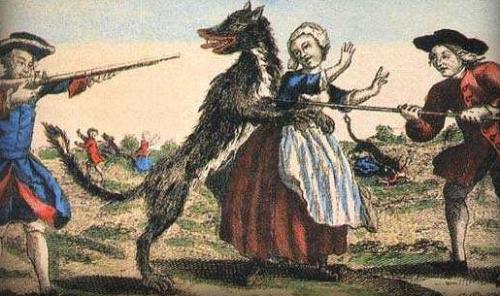
The white marking tells you that this is definitely a wolf hybrid.
***
What kind of dog was it that the wolves were crossed with to make the Beasts? The first animal was probably an F1 cross, a very high content wolf hybrid. The second animal had more dog-like characteristics. It may have been the descendant of the first. Both animals were reddish in color, big, and striped (brindled?) The white markings on the second animal tell me what it was. And the dog in the mix was a French Mastiff, a dogue, probably a red brindled one. This assertion is not far-fetched. The Spanish used their war mastiff, a close relative of the dogue, to kill native people in the New World. Dogue and wolf combine could create a mysteriously ugly monster of a hybrid, one that no one could identify as either species.
Perhaps this hybrid occurred naturally, or perhaps human agency was involved. There were plots against the French king at this time, for France had lost most of its overseas empire in the Seven Years War just before the killing started. France was a broken nation, and a monster problem that could not be solved could turn the peasants into a revolutionary state. There are some conspiracy theories that name Jean Chastel, the wolf hunter, as part of the conspiracy, along with the nobles of the region. However, I do not wish to engage in conspiracy theories on this site.
Animal Planet once had a show called Animal X, a show about cryptozoology. They covered the Beast of Gevaudan as a whodunnit, and I thought that this was about the only reasonable show of the series in terms of science. However, I still loved it for its camp factor. I love true believers in cryptids. I’m sorry I can’t join you, but I love to watch you tilt at windmills.
Read Full Post »

